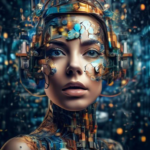In an age where pixels and algorithms blend to create breathtaking visuals and compelling art, the horizon of human imagination seems limitless. Welcome to the intriguing world of AI image generation, where machine-learning models conjure images that can be indistinguishable from those crafted by human hands. As we marvel at this technological wonder, it’s crucial to navigate the moral landscape that accompanies it. Join us on a thoughtful journey as we delve into the ethical considerations surrounding AI image generation, shedding light on the path to a future where technology and ethics walk hand in hand. Prepare to explore the delicate balance of innovation and integrity, an exploration where every pixel matters, and every decision can shape the visual fabric of our society.
Table of Contents
- Balancing Creativity and Responsibility in AI Image Generation
- Guarding Against Bias: Ensuring Fair Representation in AI Art
- Transparency and Accountability: Who Takes Credit and Blame?
- Privacy Matters: Protecting User Data in Image Creation
- Environmental Impact: Sustainable Approaches to AI Art Development
- Crafting Ethical Frameworks: Guidelines for Developers and Users
- Closing Remarks
Balancing Creativity and Responsibility in AI Image Generation
AI image generation is a dazzling frontier, offering immeasurable creative opportunities. However, it also presents a balancing act between artistic freedom and ethical responsibility. This dynamic interplay requires guidelines and practices to ensure that AI-driven creativity does not compromise ethical standards.
- **Transparency**: Creators must be clear about AI’s role in the image generation process. Users deserve to know when an artwork has been developed or assisted by AI technologies.
- **Attribution**: Giving credit where credit is due, including to the AI models and the data sets used, helps in maintaining intellectual honesty.
- **Consent**: Using images responsibly requires obtaining appropriate permissions, especially when basing AI-generated content on existing works or personal likenesses.
The rise of AI tools like DALL-E and GANs has made the distinction between human and machine creativity increasingly blurred. This necessitates guidelines to ensure that AI-generated images do not misuse copyrighted material, spread misinformation, or perpetuate biases. Clear policies should be promoted and followed within the community.
| Aspect | Creative Implication | Ethical Concern |
|---|---|---|
| Originality | Infinite new designs | Plagiarism risks |
| Speed | Rapid prototyping | Quality over quantity |
| Accessibility | Democratized creativity | Misuse potential |
In parallel, fostering a community that prioritizes responsible AI usage can mitigate risks. Adopting best practices, such as involving diverse datasets to avoid reinforcing stereotypes and biases, ensures inclusivity in AI creations. Encouraging open dialogues around these issues within the community can help in evolving better standards.
Ultimately, combining creativity with responsibility means setting a framework where innovation thrives while ethical considerations guide the process. Striking this balance will not only propel the growth of AI art but also maintain the integrity and respect of all stakeholders involved.
Guarding Against Bias: Ensuring Fair Representation in AI Art
AI art generators have opened up a world of creative possibilities, yet they also present significant challenges in maintaining fairness and avoiding bias. **Bias** can inadvertently find its way into AI systems through the data on which they are trained, impacting the representation of different cultures, genders, and socioeconomic backgrounds. To ensure equitable representation, developers must scrutinize the data sets being employed.
- Data Diversity: One imperative strategy is to incorporate a diverse array of inputs into the training data. This means sourcing images from a broad spectrum of geographical locations, cultural settings, and life scenarios.
- Bias Audits: Conducting regular bias audits can help identify any skewed patterns. This can involve both automated checks and manual reviews by individuals from various backgrounds.
- Incorporate Feedback: User feedback should be an integral part of the process, with mechanisms in place to address and fix reported biases swiftly.
| Consideration | Action Step |
|---|---|
| Data Source | Include images from multiple cultures and contexts |
| Review Frequency | Schedule periodic audits and updates |
| User Feedback | Establish robust channels for feedback |
Moreover, it’s crucial to engage diverse teams in developing and refining AI algorithms. A team with varied backgrounds can provide insights that might be missed by a homogenous group, leading to more comprehensive and nuanced understanding of fairness in AI-generated art.
Emphasizing **transparency** and **accountability** can also contribute to a more ethical approach. Publicly sharing the methodologies and data sources involved in AI training can foster trust and allow external experts to point out potential areas of improvement. By striving for a fair representation, we can ensure AI art not only innovates but also reflects the rich diversity of human experience.
Transparency and Accountability: Who Takes Credit and Blame?
In an era where AI image generation is becoming increasingly prevalent, understanding who is responsible for both successes and failures can help build trust and encourage ethical practices. It’s essential to pinpoint who should be acknowledged when things go right and who should be held accountable when they don’t.
When Initiatives Succeed:
- Developers and Researchers: The innovative minds behind the algorithms and technical frameworks.
- Businesses and Organizations: Institutes that fund and implement AI technology to address real-world challenges.
- End-Users: Artists, designers, and creators who effectively leverage AI tools to transform their visions into reality.
When Problems Arise:
- Developers: Technical issues often lie in the hands of those who create the code, underlining the need for rigorous testing and ethical guidelines.
- Companies: Ethical lapses and privacy concerns require corporate oversight to ensure AI tools are used responsibly.
- Users: End-users also need to be aware of potential misuse, such as deepfakes or intellectual property theft, and act responsibly.
Frequently, the responsibility isn’t clear-cut and can be shared among multiple parties. For example, if an AI-generated image facilitates misinformation, it might be the result of an underlying algorithm flaw or a lack of policy oversight. A combined effort is necessary to foster ethical use, from the creation of the algorithms to their final application.
Here’s a brief overview of roles and the potential risks involved:
| Role | Potential Risk |
|---|---|
| Developers | Algorithmic biases |
| Businesses | Ethical lapses |
| End-Users | Misuse and copyright issues |
Privacy Matters: Protecting User Data in Image Creation
When developing AI models for image generation, the privacy of user data must be a paramount concern. This encompasses not only the data collected during the image creation process but also how that data is processed, stored, and ultimately used. The sanctity of user privacy isn’t just a regulatory requirement—it’s a cornerstone of ethical practice.
- Data Anonymization: Before utilizing any user data, ensure it is thoroughly anonymized. This means stripping away any personally identifiable information that could link the data back to an individual.
- Explicit Consent: Always obtain explicit user consent before leveraging their data. Transparency about what data is being collected and how it will be used builds trust and aligns with ethical standards.
- Data Minimization: Only collect the data that is absolutely necessary for the task. Reducing the volume of data collected not only protects user privacy but also simplifies data management.
Additionally, robust encryption practices should be employed to safeguard data during transfer and storage. This includes both end-to-end encryption and at-rest encryption, ensuring that data remains secure at all stages. Incorporating these practices not only meets GDPR compliance but also showcases a commitment to user’s privacy.
| Practice | Benefit |
|---|---|
| Data Anonymization | Protects user identities |
| Explicit Consent | Builds user trust |
| Data Minimization | Simplifies data management |
It’s vital to conduct regular privacy assessments and audits. This ongoing vigilance helps to identify potential vulnerabilities and areas for improvement. By staying proactive, we don’t just comply with existing privacy laws—we set the standard for ethical AI practices.
By embedding these privacy principles into the very fabric of AI image generation processes, developers and companies alike can ensure they are not only creating powerful and innovative products but also respecting and protecting the individuals who make these creations possible.
Environmental Impact: Sustainable Approaches to AI Art Development
AI technology promises to reshape the creative landscape, but its environmental footprint warrants careful consideration. To promote eco-friendly AI art development, emphasis should be placed on minimizing energy consumption and utilizing renewable resources. By focusing on **energy-efficient algorithms** and **sustainable data centers**, we can significantly cut down the environmental impact.
- Opt for **renewable energy sources** to power computational processes
- Implement **energy-efficient coding practices**
- Encourage the use of **recycled hardware components**
The carbon footprint of training large AI models can be daunting. Consider the following data on the energy consumption of traditional AI models versus more sustainable practices:
| AI Approach | Energy Consumption (KwH) |
|---|---|
| Traditional Model Training | 50,000 |
| Energy-Efficient Techniques | 15,000 |
Implementing energy-efficient AI techniques not only lowers energy consumption but also aligns with global efforts to combat climate change. Some strategies include **incremental learning** and **model distillation**. These methods emphasize reducing resource usage by refining data processing and optimizing algorithms.
Moreover, involving **cross-disciplinary collaborations** ensures the integration of sustainability from both technological and artistic perspectives. By fostering a community where artists, engineers, and environmental scientists collaborate, we can drive forward the adoption of sustainable practices in AI art development.
Crafting Ethical Frameworks: Guidelines for Developers and Users
Creating ethical frameworks for AI image generation is paramount to ensure that both developers and users adhere to responsible practices. These guidelines serve as a foundation for fostering trust, accountability, and inclusivity in the development and deployment of AI technologies.
For Developers:
- Bias Mitigation: Strive to identify and reduce biases in your datasets. Implement processes for regular audits and updates to minimize the risk of perpetuating harmful stereotypes or biases.
- Transparency: Clearly communicate the capabilities and limitations of your AI models to stakeholders and end-users. Transparency builds trust and allows for informed decision-making.
- User Privacy: Incorporate privacy-preserving techniques to safeguard user data. Ensure compliance with relevant data protection regulations and promote user consent.
- Collaboration: Engage with a diverse group of stakeholders, including ethicists, legal experts, and representatives from affected communities, to refine your ethical guidelines and address potential concerns.
For Users:
- Responsible Use: Utilize AI-generated images in ways that are ethical and respectful. Avoid scenarios where these images might be used to deceive, manipulate, or harm individuals or groups.
- Critical Evaluation: Question the authenticity and source of AI-generated content. Be aware of the potential for misinformation and exercise critical thinking.
- Data Integrity: Use AI tools that prioritize data integrity and provenance. Understanding the origins of the content ensures responsible usage and maintains ethical standards.
Here is a concise summary of key considerations for ethical AI image generation:
| Aspect | Developer Guidelines | User Guidelines |
|---|---|---|
| Bias Mitigation | Regular audits, diverse datasets | Awareness of potential biases |
| Transparency | Clear communication of limitations | Informed decision-making |
| Privacy | Privacy-preserving techniques | Consent and data protection |
| Collaboration | Engage diverse stakeholders | Respectful and responsible use |
By adhering to these guidelines, both developers and users can contribute to the ethical and responsible advancement of AI image generation. The goal is to foster a technological ecosystem where innovation and ethical considerations go hand in hand, ensuring that AI serves the greater good.
Closing Remarks
As we navigate the complex landscape of AI image generation, it is crucial to approach the technology with ethical considerations in mind. By prioritizing transparency, inclusivity, and accountability, we can ensure that AI works for the greater good, contributing to a more diverse and equitable future. Let us continue to uphold ethical standards as we harness the power of AI to create and innovate. Together, we can shape a world where technology serves as a force for positive change. Thank you for joining us on this journey towards a more ethical AI future. Stay inspired, stay vigilant, and keep pushing boundaries for a better tomorrow.
































